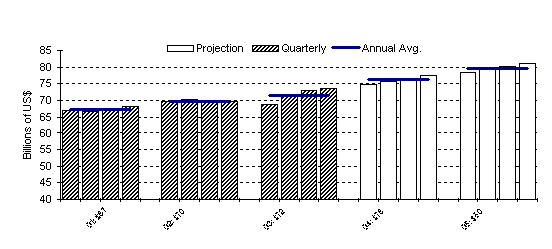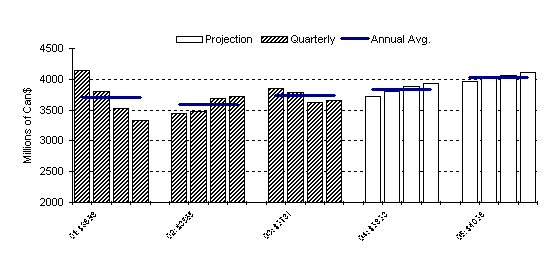 Quarterly data seasonally adjusted at
annual rates
Source: U.S. Department of Commerce,
Strategic Projections Inc., AKTRIN
|
AKTRIN MONITOR FOR CANADIAN CONSUMER SPENDING ON FURNITURE
AND BEDDING

Quarterly data seasonally adjusted at
annual rates
Source: Statistics Canada, Strategic
Projections Inc., AKTRIN
Personal income growth in Canada has been advancing at a rate of 2.7% in 2003 which is
slightly slower than the 3.3% rate in the previous year. We expect a noticeable
acceleration this year, culminating at about 4.8% (at an annualized rate) during the last
quarter, and averaging 4% for the year as a whole.
Some of the growth impetus goes on account of higher prices. If the impact of inflation
and taxes is eliminated, the performance is more modest. After advancing by only 1.1% last
year, growth of real disposable income this year and next is estimated to be in the 2.8%
range. ??
The Canadian residential housing market is a bit oversupplied and decelerating at the
moment. In value terms it advanced by 7.4% last year, down from a staggering 14.2% rate in
2002. Growth this year may be still a bit slower, that is at an estimated rate of 6.9%. In
volume terms this represents 203,000 new units compared to 220,000 units in 2003.
|
|

Quarterly data seasonally
adjusted at annual rates
Source: Statistics Canada, Strategic
Projections Inc., AKTRIN
Business investments are strongly influenced by corporate profits, albeit with a
considerable time lag. Investments in machinery and equipment fell by -6.0% in 2002 and
rose by only 3.4% last year. Fortunately, relatively strong governmental expenditures
offered a counterbalance to the weak private sector investments.
Due to the general improvements in the economy, investment growth is likely to advance by
a healthy 8.3% this year and may be even better next year. This, however, is dependent on
a continuation of low interest rates.
One of the strongest segments in the Canadian economy was the employment market. It has
been growing at 2.2% both in 2002 and 2003. This is equivalent to some 600,000 new jobs
each year. Employment growth is likely to moderate a bit this year but we do not believe
that it will drop below 2%.
There is sufficient vacant office space available in Canada to accommodate any expansion
of office jobs. The subdued activity in office building construction during the past few
years does not create an impediment to the growth of office employment at the present
time. Furthermore, we anticipate that commercial construction will gather some steam this
year and next. We predict an annual growth rate in excess of 5% (in value terms).
The Canadian office furniture market (at retail prices and including recycled furniture)
grew rapidly up to 2001. However, in 2002 the market size came in at only C$ 3585 million
or 3.1% below the previous year' value. This represented a drop of or C$ 113 million. ?
Last year witnessed some improvements with an annual growth rate of 4.1%. This year,
growth may slow down again to a rate of about 2.7%. In value terms, we predict a market
size of C$ 3833 million, up from C$ 3731 million in 2003.
|